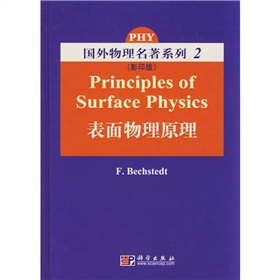国外物理名著系列2:表面物理原理 电子书下载 PDF下载

内容简介
本书以新颖的视角全面介绍了表面的几何结构和电子结构。所涉及的表面包括共价键和离子健结合的固体表面以及金属表面。本书重在基础部分,比如表面结晶和热力学原理,促使原子重新排列的力,成健与电子结构之间的关系等。本书阐述了表面晶向、化学成分、热力学条件以及由此产生的各种性质之间的联系,表面上的激发及其表述与测量。书中的讨论和方法有助于读者分析新型表面和新材料间的界面。本书是从事表面生长、表面分子相互作用、自组装结构、材料性能工程和新材料研究的科技工作者不可缺少的参考书。
·查看全部>>
目录
1.Symmetry
1.1 Model Surfaces
1.1.1 Surface Versus Bulk
1.1.2 The Surface as a Physical Object
1.2 Two-Dimensional Crystals
1.2.1 Lattice Planes of Bulk Crystals
1.2.2 Oriented Slabs
1.2.3 Ideal Surfaces.Planar Point Groups
1.2.4 Real Surfaces:Reconstruction and Relaxation
1.2.5 Superlattices at Surfaces
1.2.6 Wbod Notation
1.2.7 Symmetry Classification
1.3 Reciprocal Space
1.3.1 Direct and Reciprocal Lattices
1.3.2 Brillouin Zones
1.3.3 Projection of 3D Onto 2D Brillouin Zones
1.3.4 Symmetry of Points and Lines in Reciprocal Space
2.Thermodynamics
2.1 Kinetic Processes and Surfaces in Equilibrium
2.2 Thermodynamic Relations for Surfaces
2.2.1 Thermodynamic Potentials
2.2.2 Surface Modification of Thermodynamic Potentials
2.2.3 Surface Tension and Surface Stress
2.3 Equilibrium Shape of Small Crystals
2.3.1 Anisotropy of Surface Energy
2.3.2 Absolute Values for Surfaee Energies
2.3.3 Wulff Construction
2.4 Surface Energy and Morphology
2.4.1 Facetting and Roughening
2.4.2 3D Vcrsus 2D Growth
2.4.3 Formation of Quantum Dots
2.5 Stoichiometry Dependence
2.5.1 Thermodynamic Approach
……
3.Bonding and Energetics
4.Reconstruction Elements
5.Elementary Excitations Ⅰ:Single Electronic Quasiparticles
6.Elementary Excitations Ⅱ:Pair and Collective Excitations
7.Defects
References
Index
1.1 Model Surfaces
1.1.1 Surface Versus Bulk
1.1.2 The Surface as a Physical Object
1.2 Two-Dimensional Crystals
1.2.1 Lattice Planes of Bulk Crystals
1.2.2 Oriented Slabs
1.2.3 Ideal Surfaces.Planar Point Groups
1.2.4 Real Surfaces:Reconstruction and Relaxation
1.2.5 Superlattices at Surfaces
1.2.6 Wbod Notation
1.2.7 Symmetry Classification
1.3 Reciprocal Space
1.3.1 Direct and Reciprocal Lattices
1.3.2 Brillouin Zones
1.3.3 Projection of 3D Onto 2D Brillouin Zones
1.3.4 Symmetry of Points and Lines in Reciprocal Space
2.Thermodynamics
2.1 Kinetic Processes and Surfaces in Equilibrium
2.2 Thermodynamic Relations for Surfaces
2.2.1 Thermodynamic Potentials
2.2.2 Surface Modification of Thermodynamic Potentials
2.2.3 Surface Tension and Surface Stress
2.3 Equilibrium Shape of Small Crystals
2.3.1 Anisotropy of Surface Energy
2.3.2 Absolute Values for Surfaee Energies
2.3.3 Wulff Construction
2.4 Surface Energy and Morphology
2.4.1 Facetting and Roughening
2.4.2 3D Vcrsus 2D Growth
2.4.3 Formation of Quantum Dots
2.5 Stoichiometry Dependence
2.5.1 Thermodynamic Approach
……
3.Bonding and Energetics
4.Reconstruction Elements
5.Elementary Excitations Ⅰ:Single Electronic Quasiparticles
6.Elementary Excitations Ⅱ:Pair and Collective Excitations
7.Defects
References
Index
同类热门电子书下载更多
Copyright © 2025 by topbester.com.
All Rights Reserved.
沪ICP备14027842号-1
All Rights Reserved.
沪ICP备14027842号-1